MARIANI’S
Virtual Gourmet
MAY 24,
2015
NEWSLETTER
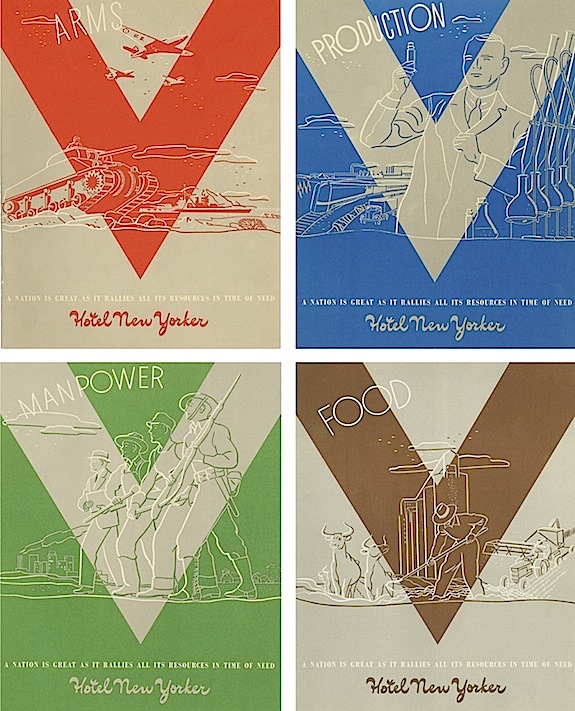
HOTEL NEW YORKER MENU, 1943
COMMEMORATE
MEMORIAL DAY
❖❖❖
IN THIS ISSUE
CHARLOTTESVILLE, VIRGINIA
By John Mariani
NEW YORK CORNER
ARTHUR AVENUE'S BEST RESTAURANTS
By John Mariani
NOTES FROM THE WINE CELLAR
KRUG CHAMPAGNE IN A CLASS OF ITS OWN MAKING
By John Mariani
❖❖❖
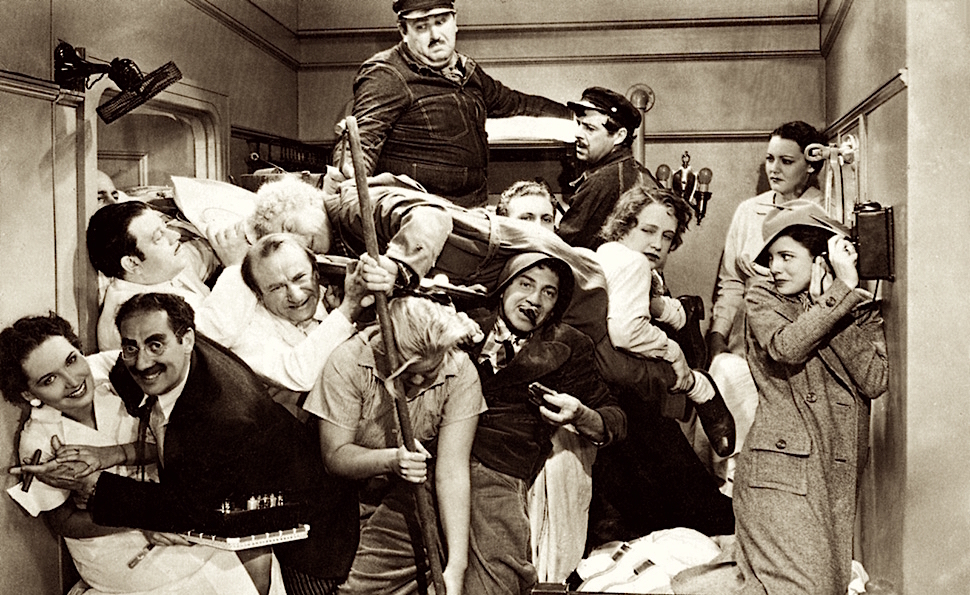 ANNOUNCEMENT!
ANNOUNCEMENT!
There will be no issue of the Mariani's Virtual Gourmet next week because Mariani will be on a cruise ship crossing the Atlantic.
Next Issue: June 7
❖❖❖
CHARLOTTESVILLE, VIRGINIA
By John Mariani

Barboursville Vineyards and Farm
In addition to its
illustrious historical record--once home to Thomas
Jefferson, James Madison and James Monroe--and one
of America’s great and most beautiful schools, the
University of Virginia (below), the city of
Charlottesville has a new reason to boast: Prince
William and Princess Kate’s new baby girl has been
named Charlotte. The colonial Virginia city was
named after Queen Charlotte, bride of George III
(who, ironically, was the King of England during
the Revolutionary War).
For its Georgian architecture
(Jefferson founded and designed several buildings on
the University campus) and its proximity to
Shenandoah National Park and the Blue Ridge Parkway,
Charlottesville draws more than half a million
tourists each year, swelled by 20,000 students. All
of them can be found strolling the long Downtown
Mall lined with restaurants, coffee shops, the Live
Arts community theater and the Virginia Discovery
Museum. Next
month the Festival of the Photograph will be held,
followed by the Film Festival in October.
On Saturdays, the City Market
with its street food eateries is very popular, but
downtown is largely undistinguished for upscale
dining, catering instead to the student and
professor population at places with names like
Himalayan Fusion, Jack Brown’s Beer & Burger
Joint, and Jak-N-Jil.
The best restaurants are mostly outside of
town, including the Old Mill Room at Boar’s Head and Fossettt’s at Keswick
Hall.
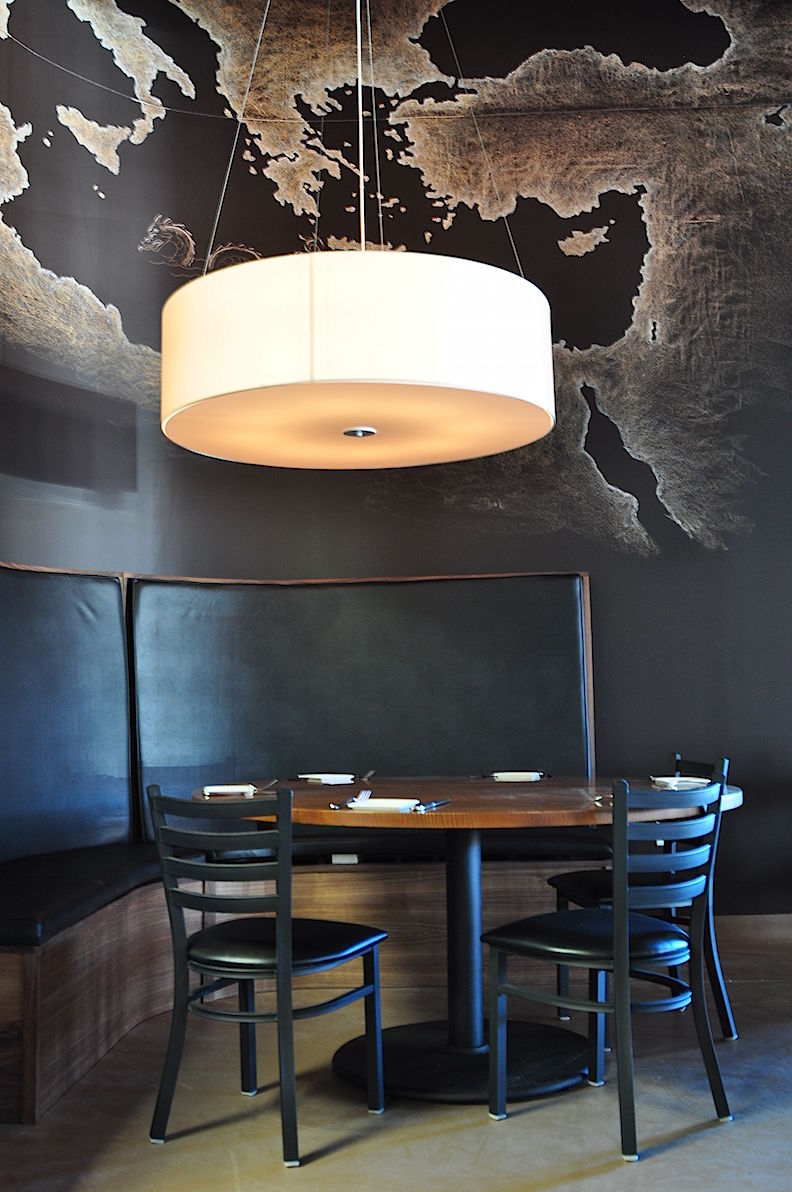 I had the
happy occasion to dine at a new place with the
curious name Parallel 38,
which refers to the latitude of Mediterranean
countries whose food is featured there. Residing
within an upscale shopping center, it is a vast
dining hall (left)
with a soapstone
bar, reclaimed factory cart seating, a beautiful
chalkboard mural and a 12-foot walnut table. The
intrusive Techno-music has nothing to do with the
Mediterranean theme.
I had the
happy occasion to dine at a new place with the
curious name Parallel 38,
which refers to the latitude of Mediterranean
countries whose food is featured there. Residing
within an upscale shopping center, it is a vast
dining hall (left)
with a soapstone
bar, reclaimed factory cart seating, a beautiful
chalkboard mural and a 12-foot walnut table. The
intrusive Techno-music has nothing to do with the
Mediterranean theme.
Owner Justin Ross, who’d worked at Zaytinya
and Jaleo in DC,
is as affable as they come and truly enjoys
suggesting an array of small plates (below),
engagingly prepared and plated. I was happy to
let them choose my meal, which began with fine
artisanal cheeses and cured meats from Virginia and
Maryland ($6-$9), along with some delectable spreads
like Greek htipiti
with
roasted peppers, feta and thyme ($7) and Lebanese labneh
yogurt with zatar
spice mixture ($7).
Under the menu's Vegetable
section there is a delicious, tender gnocchi with
a sweet onion soubise,
hot peperonata
and herbs ($8). Among the meats, I most enjoyed a
grilled lamb strip loin cooked in bacon fat with
fingerling potatoes and butter blended with a ras el hanout
spice mixture ($13) and a roasted pork belly with
baby onions, roasted garlic and sumac ($11). Spicy
tuna tartare with chili sauce and sesame soy ($11)
made for a good seafood selection. For
dessert the simple, nicely grainy olive oil lemon
cake came with vanilla ice cream. 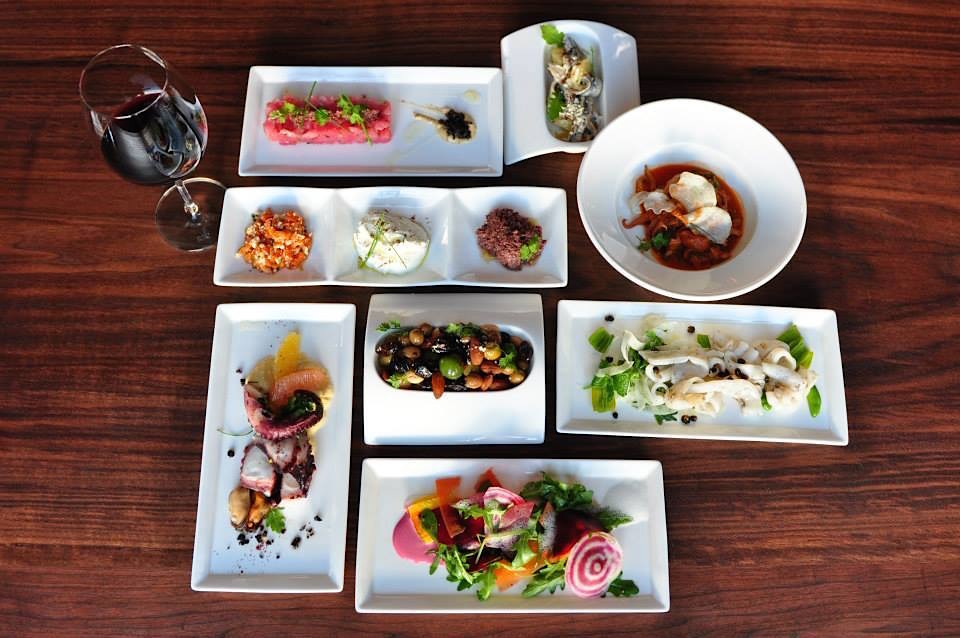
At these prices you can choose a
slew of dishes, even share them with another person,
and be very satisfied, particularly because this
kind of food and design are rare indeed in this
area. Also,
every wine on the list, even the “Trophy” bottles,
are available by the glass at very reasonable
prices.
Far more
traditional in décor is The Ivy Inn
restaurant (below),
dating to the 1700s, which is, in fact, just a mile
from the University. The red clapboard house with
white porch evokes a less hectic era, and the
interior, with its draped tables, candlelight,
ceiling beams, wood floors and fireplace, has the
genteel ambiance of a splendid country home
Jefferson would certainly have found congenial.
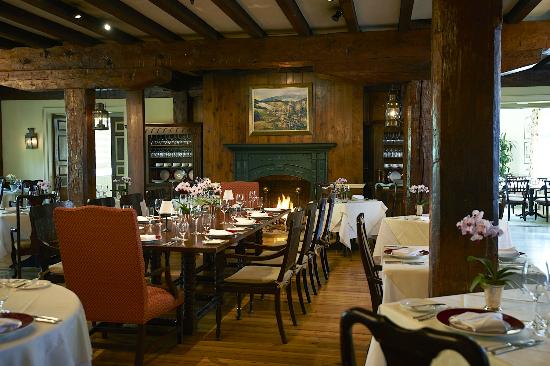 The Inn has
been owned by the Vangelopoulos family since 1995
and Fairfax County native Angelo
Vangelopoulos sources all he can from local farmers
for his kitchen larder. Thus, while you can find
down-home favorites refined by focused technique
like the shrimp and grits with a country ham butter
sauce and crispy onion rings ($11) and a lustrous
tomato pie ($8), there are also global dishes like
his sheep’s milk ricotta gnocchi
enriched by red wine-braised duck, wild mushrooms
and roasted garlic jus ($10/$18),
as well as ravioli stuffed with roasted eggplant and
ricotta ($8/$15), a
dish over-elaborated with Portobello
Bolognese sauce, spinach, mascarpone cream and
Parmigiana.
The Inn has
been owned by the Vangelopoulos family since 1995
and Fairfax County native Angelo
Vangelopoulos sources all he can from local farmers
for his kitchen larder. Thus, while you can find
down-home favorites refined by focused technique
like the shrimp and grits with a country ham butter
sauce and crispy onion rings ($11) and a lustrous
tomato pie ($8), there are also global dishes like
his sheep’s milk ricotta gnocchi
enriched by red wine-braised duck, wild mushrooms
and roasted garlic jus ($10/$18),
as well as ravioli stuffed with roasted eggplant and
ricotta ($8/$15), a
dish over-elaborated with Portobello
Bolognese sauce, spinach, mascarpone cream and
Parmigiana.
A bison hanger steak ($28) was
perfectly cooked medium rare and came with assertive
horseradish-flecked scalloped potatoes, sauce chasseur,
more wild mushrooms and sautéed greens. The cooking
has unusual finesse, evident in the chef’s sautéed
duck breast with leek-potato cake, a tangy-sweet
cherry sauce and sautéed spinach ($28).
If you don’t opt for the cheese plate ($14)
with selections like Goat Lady “Lindale” Gouda from
Climax, NC, and the Caramount Red Row from Esmont,
VA, you’ll thoroughly enjoy pastry chef Kristyne
Bouley’s sticky toffee pudding with pecan praline
and vanilla ice cream ($8) and the well balanced Key
lime pie ($8).
The
Ivy Inn boasts one of the area’s very finest wine
lists, with a few (there should be more) of the
ever-improving Virginia wines from estates like
Naked Mountain, Akida, Blenheim, and Barboursville. This last
estate is the finest of Virginia’s more than 250
wineries. Set on 900 acres of rolling hills of the
same name, it is owned by Gianni Zonin, from Italy’s
Veneto region, and since 1990 has been overseen by
winemaker 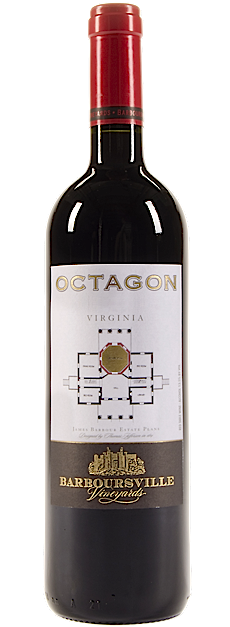 Luca
Luca 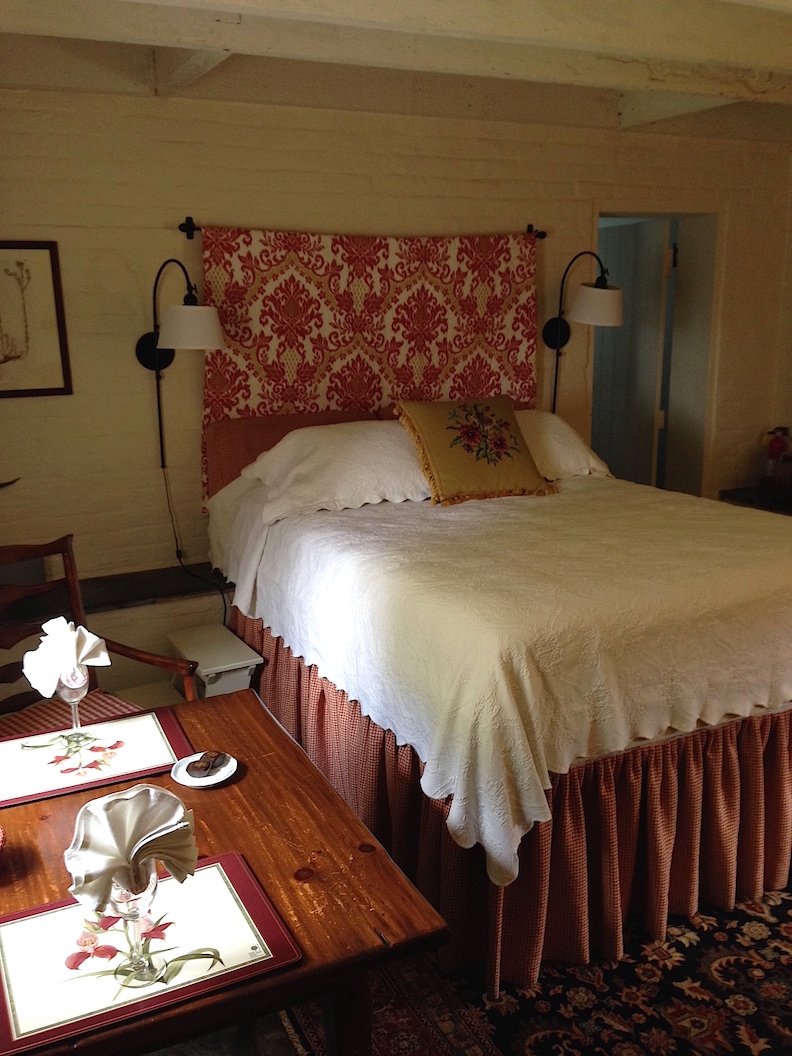 Paschina, from Piemonte. Together
they aim to create wines that shy away from the
boldness of California bottlings in favor of a
finesse more akin to European examples, which
include Italian varietals like Nebbiolo and
Vermentino along with Viognier, Cabernet Franc and
others. Their
finest wine is Octagon ($55), whose name
commemorates the octagon drawing room designed for
Governor James Barbour’s mansion, now part of the
estate, by wine-loving Thomas Jefferson, who
planted, unsuccessfully, vineyards at his Monticello
estate.
Paschina, from Piemonte. Together
they aim to create wines that shy away from the
boldness of California bottlings in favor of a
finesse more akin to European examples, which
include Italian varietals like Nebbiolo and
Vermentino along with Viognier, Cabernet Franc and
others. Their
finest wine is Octagon ($55), whose name
commemorates the octagon drawing room designed for
Governor James Barbour’s mansion, now part of the
estate, by wine-loving Thomas Jefferson, who
planted, unsuccessfully, vineyards at his Monticello
estate.
Octagon is a blend of
Merlot, Cabernet Franc and Petit Verdot in the style
of France’s Pomerol and is made only in optimum
years. As
Paschina says, “It
is harder for a grape to get into Octagon than any
other wine in our region."
The estate also has
an inn dating to 1804, with a number of enchanting
rooms that evoke 19th century rural architecture,
and vineyard-set cottage suites named after grape
varietals. Of
course, with accommodations there comes a
restaurant, not surprisingly, Italian in its
cuisine, offering housemade charcuterie; risotto
with fava beans and crispy tripe; roasted game hen
with sautéed asparagus, new potatoes and spring
onions; and an apricot turnover with crème fraȋche
ice cream and pistachios. Two courses cost $41,
three $47, and four $55, with paired wines extra, if
desired.
After
such a meal at twilight this summer, you walk slowly
back to your cottage (left), crawl under a quilt, listen
to the sounds of the farm, and drop into a long,
deep sleep dreaming of the breakfast biscuits to
come.
❖❖❖
By John Mariani
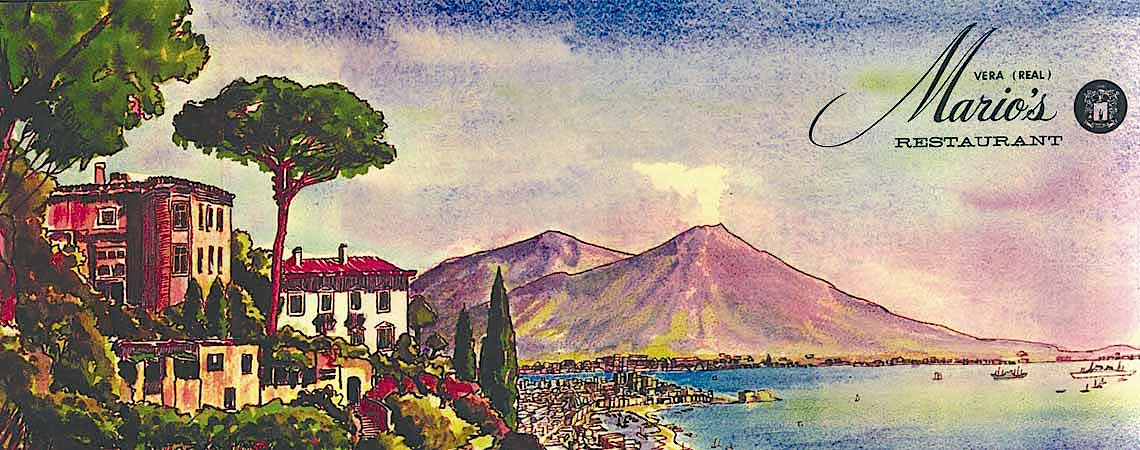
If you’ve been to Little Italy
in Manhattan and were disappointed by the
tourist-trap atmosphere and the forgettable food,
it’s because you went to the wrong place.
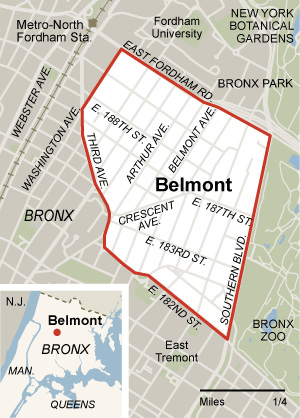 The real Little
Italy
is a vibrant neighborhood in the Bronx called Belmont,
half a mile from the Bronx Zoo and Botanical
Gardens. Others call it Arthur Avenue, the
neighborhood’s main street, bisected by East 187th
Street, lined with restaurants, pizzerias, meat and
fish markets, bakeries and pastry stores.
The real Little
Italy
is a vibrant neighborhood in the Bronx called Belmont,
half a mile from the Bronx Zoo and Botanical
Gardens. Others call it Arthur Avenue, the
neighborhood’s main street, bisected by East 187th
Street, lined with restaurants, pizzerias, meat and
fish markets, bakeries and pastry stores.
This is the Bronx the way it was
in the 1950s, when Joe DiMaggio, Phil Rizzuto, Yogi
Berra, Rocky
Marciano, Jake
LaMotta, and Julius LaRosa ate in the local
restaurants, and, later, Muhammud Ali, Liz Taylor,
Paul Newman, and James Gandolfini. Most important,
it was home to Dion Dimucci, who named his do-wop
group the Belmonts.
Years
ago the restaurants of the neighborhood were so
insular that menus varied little, the ingredients
were cheap, and
the wine lists boring. But in the past two decades
all that has changed, so that now even the real
old-timers have upped their game and you can eat
extremely well within a primarily Italian-American
style, influenced by Neapolitan and Sicilian
cookery.
I shop on Arthur Avenue weekly, so I have my
definite favorite restaurants I recommend to New
Yorkers from other boroughs and visitors from
anywhere. This is the way this food should be made.
One of the
oldest restaurants on Arthur Avenue is Mario’s,
which started as a pizza window shop in 1919, and is
still run by the Miglucci family, whose fourth and
fifth generation members are always there to
maintain an unwavering consistency--not just with
the nonpareil pizzas but with superb linguine with
clams, tender,  light potato gnocchi in
a bright tomato sauce, and tiny pink lamb chops you
pick up by the bone to eat, called scottaditti,
which means “finger burners.” Freshness rules
this kitchen and you taste it in the veal alla parmigiana,
the mozzarella loaf called spiedini alla
romana, and the hearty seafood stew zuppa di pesce.
light potato gnocchi in
a bright tomato sauce, and tiny pink lamb chops you
pick up by the bone to eat, called scottaditti,
which means “finger burners.” Freshness rules
this kitchen and you taste it in the veal alla parmigiana,
the mozzarella loaf called spiedini alla
romana, and the hearty seafood stew zuppa di pesce.
Pizza is always served but
after 6 PM you have to order something more, so
treat a pizza as an appetizer, and don't miss the
wonderful food afterwards. But to miss this great
pizza is to miss a dish perfected over nearly a
century in business.
And you will never
be treated better in a restaurant than you will be
at Mario’s, whether you’re a regular or on your
first time through the door. The
dining room (right)
always looks festive, its murals evoke Naples, and
the photos on the wall show that Mario’s has long
been a destination for every sports figure and movie
star who have been guided to it. It's always
an ebullient atmosphere, lighted so you see everyone
in the room, which on weekends is packed, so I
recommend going during the week to get a better
sense of the charm of the place.
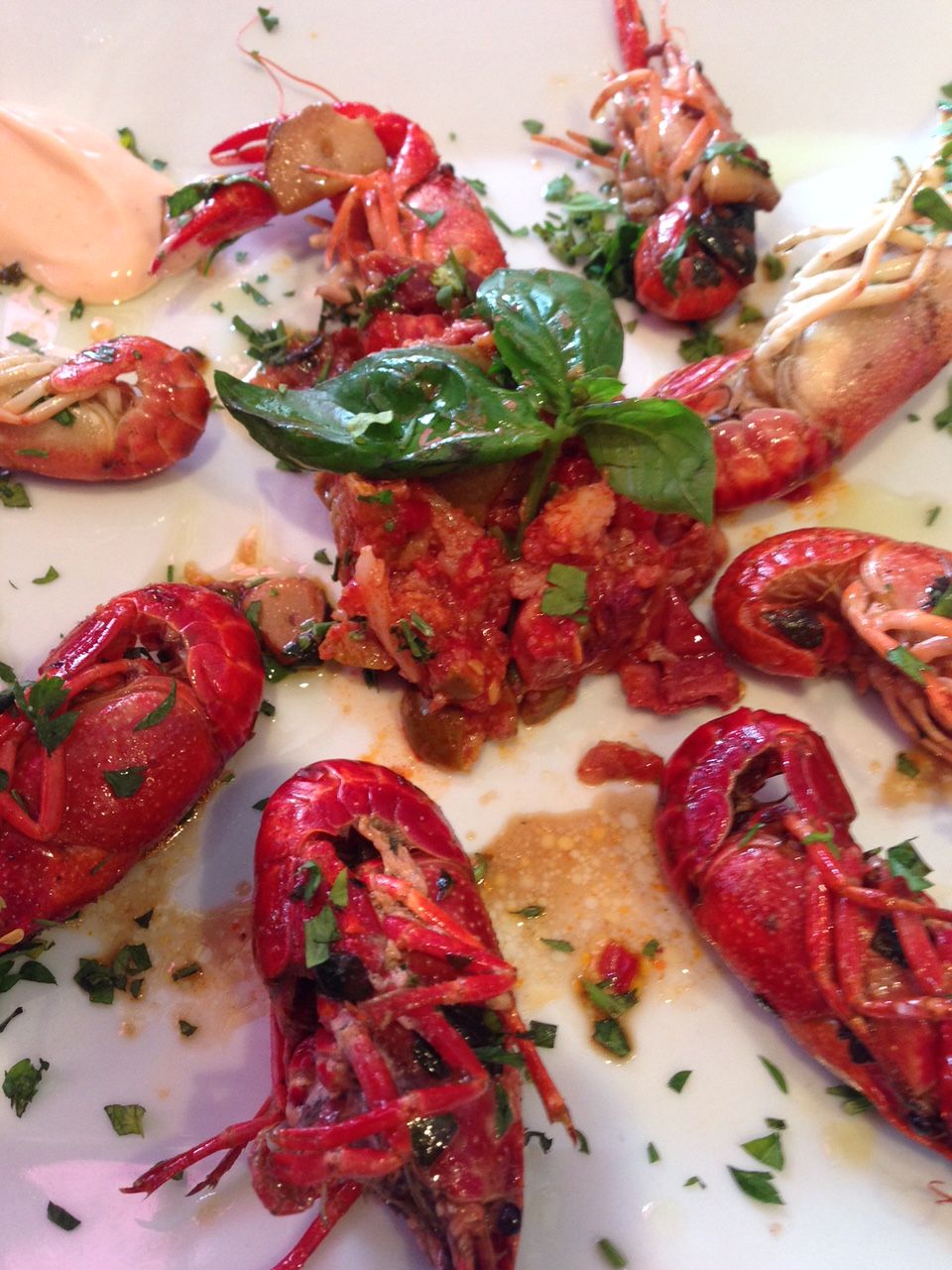 Across the
street is a bright, very cheerful small trattoria
named San Gennaro,
where chef-owner Gennaro Martinelli is working
outside the traditional menu with dishes based on
what’s freshest and seasonal in the markets from
which they cull their seafood, meats and vegetables
right there on Arthur Avenue. If there
are crayfish (left)
available for a day or two, you’ll find them
glistening on your plate with crushed tomatoes,
olive oil and vinegar. Soft shell crabs will be
lightly battered and sautéed crisp and golden,
succulent within.
Housemade ravioli, full of moist ricotta and
graced with a ragù,
are radiant and delicious, the linguine with tiny,
sweet vongole
clams is rich with garlic and served in the shell,
and his spaghetti
alla carbonara, with egg heated by the
pasta itself, is textbook perfect. The wine
list needs serious bolstering.
Across the
street is a bright, very cheerful small trattoria
named San Gennaro,
where chef-owner Gennaro Martinelli is working
outside the traditional menu with dishes based on
what’s freshest and seasonal in the markets from
which they cull their seafood, meats and vegetables
right there on Arthur Avenue. If there
are crayfish (left)
available for a day or two, you’ll find them
glistening on your plate with crushed tomatoes,
olive oil and vinegar. Soft shell crabs will be
lightly battered and sautéed crisp and golden,
succulent within.
Housemade ravioli, full of moist ricotta and
graced with a ragù,
are radiant and delicious, the linguine with tiny,
sweet vongole
clams is rich with garlic and served in the shell,
and his spaghetti
alla carbonara, with egg heated by the
pasta itself, is textbook perfect. The wine
list needs serious bolstering.
Over the past two years I’ve
found myself returning again and again to Tra di Noi on
East 187th Street, whose sunny dining room with the
requisite red-checkered tablecloths is the setting
for Chef-owner Marco Coletta’s generous, highly
personalized cooking, where regulars ignore the
printed menu in favor of the blackboard of daily
specials, which might include unusual pastas like
fusilli with fava beans ($16.95) and rigatoni (below) in a
spicy amatriciana
sauce ($16.95). There is perfectly fried calamari
($12.95) and
robust chicken alla
scarpariello ($18.95)
rich with garlic.
The osso
buco may be the best in the area. Marco
hails from the Abruzzo province of Italy, so ask him
if he’s serving any of his regional favorites.
($18.95)
rich with garlic.
The osso
buco may be the best in the area. Marco
hails from the Abruzzo province of Italy, so ask him
if he’s serving any of his regional favorites.
One of the culinary pioneers of the
neighborhood is Roberto Paciullo, who 12 years ago
opened a namesake trattoria that strayed far from
the formulaic menus in order to focus on unusual
dishes that may only be available that day. Roberto's
(below) is
where you go for dishes like tender rabbit braised
with tomato and onions; spaghetti steamed with leeks
and porcini mushrooms
in a foil pouch; a massive sirloin slathered with
melting Gorgonzola cheese; for an antipasto there
might be short ribs with sun-dried peppers, bright
arugula and a spicy olive oil; the special pasta one
day may be tender risotto with cuttlefish and its
purple-gray ink and shrimp. Softshell crabs in
season are crisp and full of fat. One of the
simplest dishes is the best: fettuccine with
parmigiano and shaved black truffles. In
autumn those will be white truffles. And to finish,
a lemony torta
cake, all
accompanied by the area’s best wine list. Downstairs is a
room bordering the glassed-in wine cellar, which
is easily the best in the neighborhood.
And
don’t be surprised if you sit next to celebs like
former Yankees manager Joe Torre, actress Marisa Tomei or TV
chef Mario Batali.
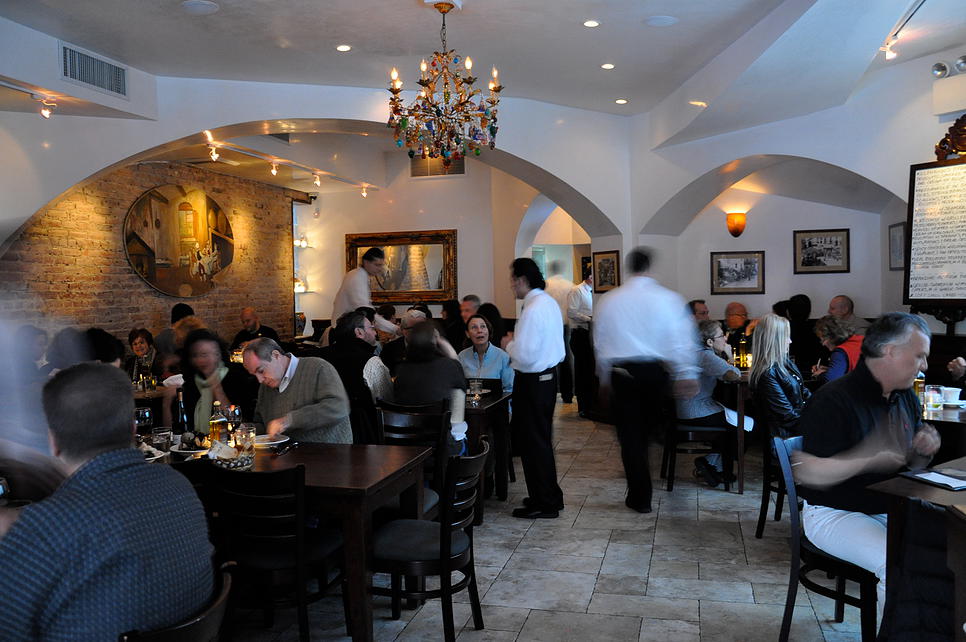 Roberto
also owns Zero Otto Nove,
which means 089, the area code for Salerno, Italy,
from which he emigrated. Having proven himself as a
fine restaurateur, Roberto swore he would open a
great, modern pizzeria--this in a neighborhood full
of good ones--and he has succeeded (now with
branches in Manhattan and Westchester County).
Roberto became a local hero when he demolished a
much-despised McDonald’s to open in this two-story
building, whose shadowy décor and corridors mimic
the narrow streets of his hometown.
Roberto
also owns Zero Otto Nove,
which means 089, the area code for Salerno, Italy,
from which he emigrated. Having proven himself as a
fine restaurateur, Roberto swore he would open a
great, modern pizzeria--this in a neighborhood full
of good ones--and he has succeeded (now with
branches in Manhattan and Westchester County).
Roberto became a local hero when he demolished a
much-despised McDonald’s to open in this two-story
building, whose shadowy décor and corridors mimic
the narrow streets of his hometown.
There is a big, open
wood-burning pizza oven, and the pies themselves--13
varieties--are Salerno-style, with a crispy outer
crust that mellows into a softer crust in the
middle, with wonderfully fresh toppings like
butternut squash puree, smoked mozzarella, pancetta
ham, béchamel sauce, and porcini mushrooms.
But
the pizzas are only the beginning at Zero Otto Nove,
whose menu offers fabulous baby octopus cooked 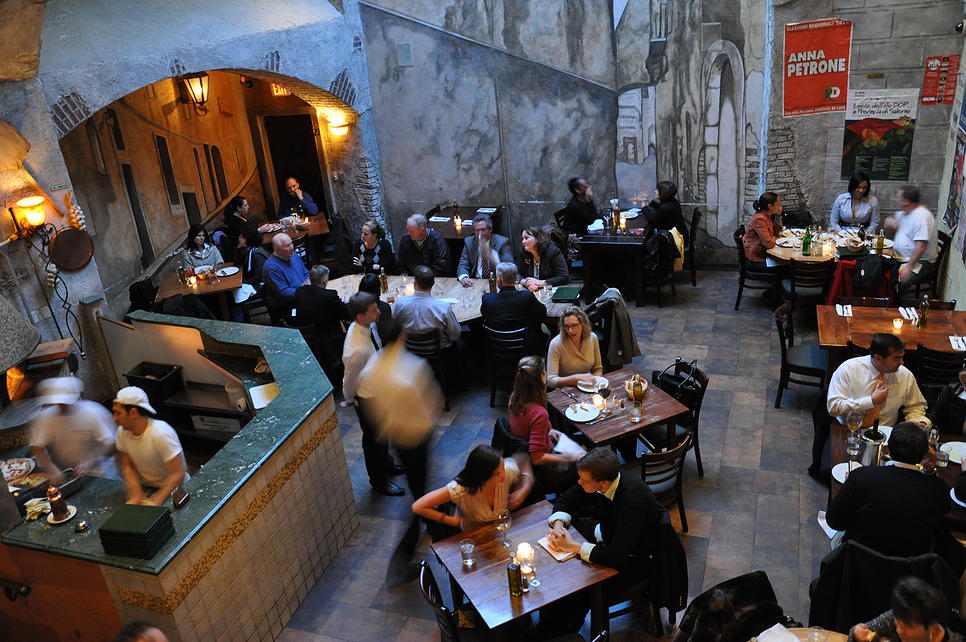 in tomato sauce, lusty pastas like pasta e fagioli
azzeccata baked with cannellini beans and
prosciutto, and linguine in a silky black sauce
teeming with calamari and cuttlefish. For dessert go
with the Nutella pizza or the torta della
nonna (“grandma’s tart”) with almond cream and
pine nuts.
in tomato sauce, lusty pastas like pasta e fagioli
azzeccata baked with cannellini beans and
prosciutto, and linguine in a silky black sauce
teeming with calamari and cuttlefish. For dessert go
with the Nutella pizza or the torta della
nonna (“grandma’s tart”) with almond cream and
pine nuts.
The best Italian
charcuterie and hero sandwiches, along with an
eggplant parmigiana that beat TV chef Bobby Flay’s
in a smackdown, is found at Mike’s Deli,
where the indefatigable David Greco (below) and his
irascible father, Mike, stock a daunting array of
salami, cheeses--including handmade mozzarella
produced several times a day on premises--hams,
marinated vegetables, and baked pastas that can be
eaten at the tables adjacent to the deli. It's as close as you'll
come in America to a true salumeria-trattoria of a
kind you'll find all over Naples and Palermo, from
which come many of the products David
imports. He also supplies the cheery
Bronx
Beer Hall on the same premises,
often thronged with Fordham University students,
which proudly serves brews made at nearby breweries.
 There
have been some culinary intruders into the
overwhelmingly Italian dining scene in Belmont,
several from Eastern Europe, including the beautiful
Blue
Mediterranean restaurant (below), whose
menu, while listing more and more Italian dishes,
shows its real eminence in carefully, simply cooked
Mediterranean seafood of very high quality, glossed
with olive oil and a squirt of lemon. There’s a
friendly raw bar that serves an abundant seafood
plateau for two ($55), rigatoni with mussels ($18),
and,
There
have been some culinary intruders into the
overwhelmingly Italian dining scene in Belmont,
several from Eastern Europe, including the beautiful
Blue
Mediterranean restaurant (below), whose
menu, while listing more and more Italian dishes,
shows its real eminence in carefully, simply cooked
Mediterranean seafood of very high quality, glossed
with olive oil and a squirt of lemon. There’s a
friendly raw bar that serves an abundant seafood
plateau for two ($55), rigatoni with mussels ($18),
and, 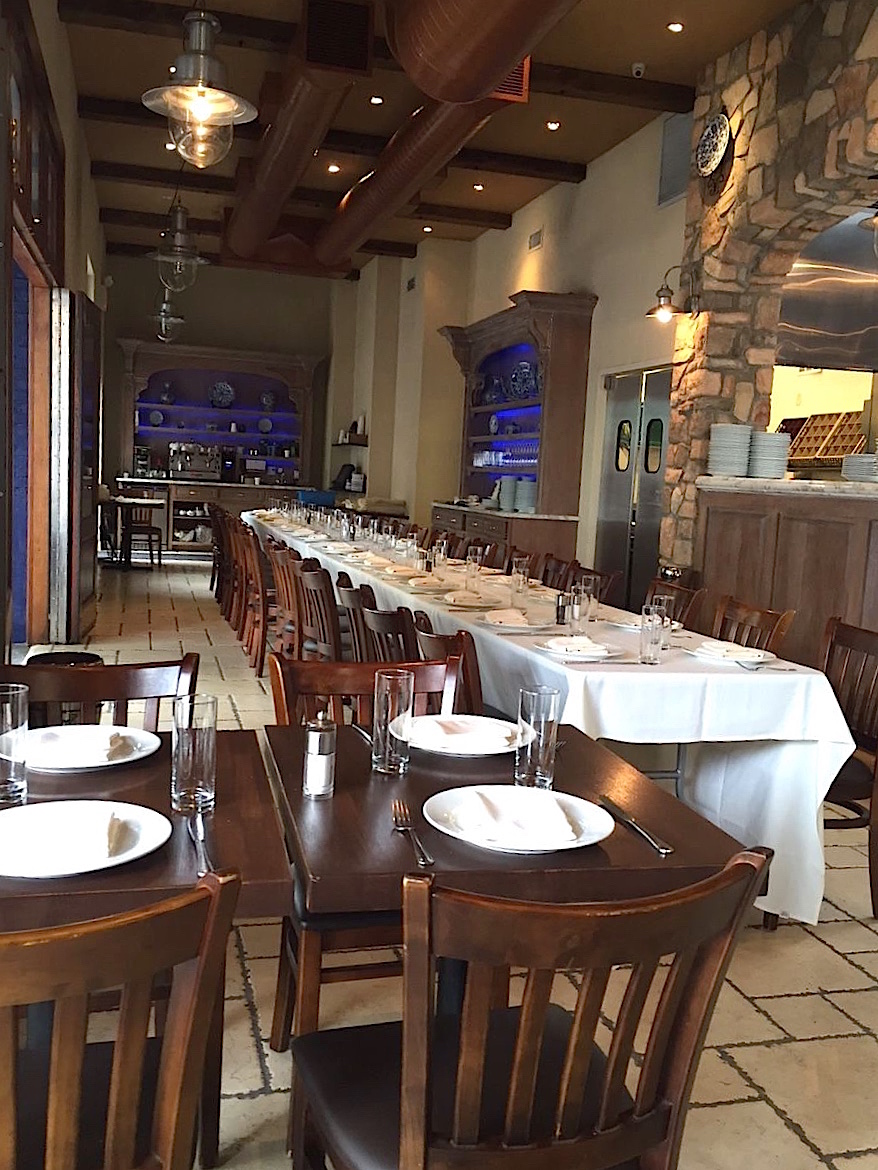 when available, wild shrimp and
grilled langoustines (market price). Frankly,
I haven’t tried the Italian dishes here because I
could never be weaned from the Mediterranean-style
seafood that Blue does better than anyone else in
the neighborhood.
when available, wild shrimp and
grilled langoustines (market price). Frankly,
I haven’t tried the Italian dishes here because I
could never be weaned from the Mediterranean-style
seafood that Blue does better than anyone else in
the neighborhood.
I happily live just fifteen minutes from Belmont,
which I've adopted as my second home. But if
you go--and it's worth a trip from Manhattan by
subway or, more easily, my Metronorth to the Fordham
station--the experience may become one that you will
tell friends about wherever you live. Already
on the weekends, tour buses arrive on Arthur Avenue
from Westchester, Connecticut, and New Jersey, and
there are Italians who long ago moved to Long Island
who come back for what they can't find where they
live. Nostalgia is always a draw--once or
twice--but it is the quality and atmosphere of
Arthur Avenue that makes it very, very special.
❖❖❖
 KRUG
CHAMPAGNE IN A CLASS OF ITS OWN MAKING
KRUG
CHAMPAGNE IN A CLASS OF ITS OWN MAKING
By John Mariani
More than once while I was at
Krug in Reims last month was I told that the
illustrious Champagne house, despite the quality
and price of its wines, did not want to be a
“connoisseur’s wine.” It simply wants to be the
finest--a status it largely enjoys among lovers
of bubbly and one I’d certainly agree with.
As explained by sixth-generation family member
Olivier Krug, Chef de
Caves Eric Lebel and the formidable CEO Margareth Henriquez (below), to be
labeled a “connoisseur’s Champagne” is to be put
into a lofty category that may put off those who
simply want to enjoy their Champagne, and Krug’s
aim is to make Champagne more accessible and less
the cause for a special event. “We don’t want to
scare people,” said the Venezuelan-born Henriquez,
who prefers to be called Maggie.
Of course, with prices that can exceed $2,000 for
Krug's top cuvées, most people are unlikely to pop
the cork for a Wednesday night dinner. But, Maggie
told me, Krug doesn’t want to share the image of
haute couture as an extravagant novelty; instead,
she said, “We are simply committed to doing what
Krug intended from the beginning--to make a
Champagne that was refined, elegant and consistent
every year.”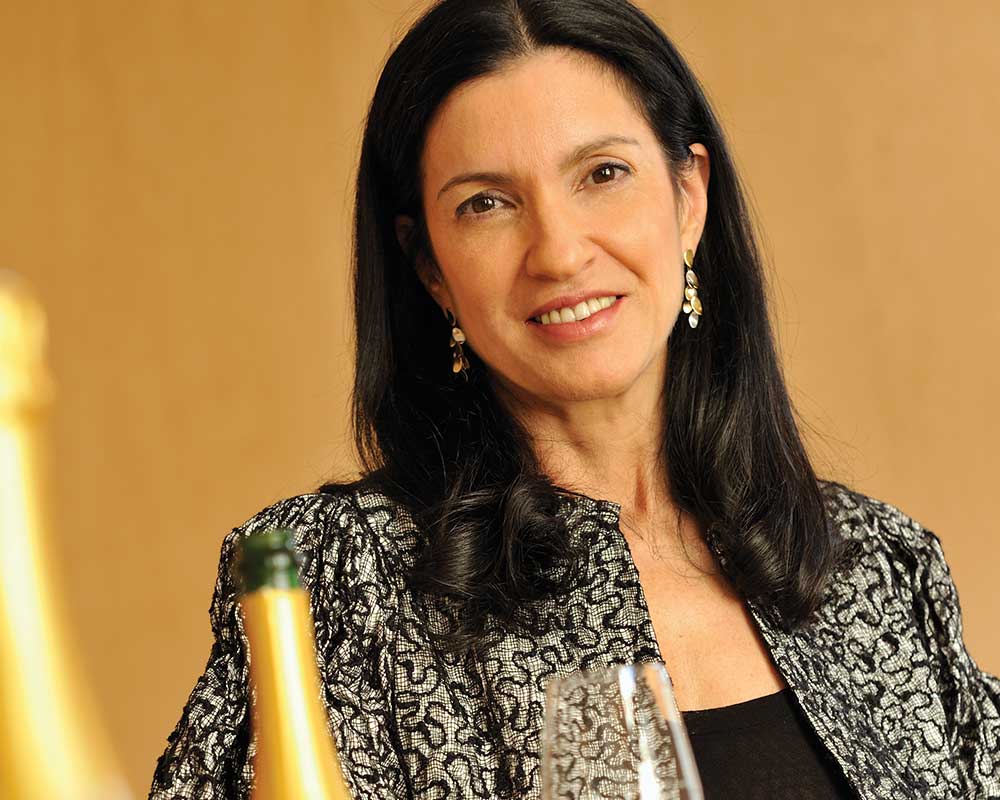
That commitment began with the founding of
the Champagne house by Joseph
Krug, who was born in 1800 in the German town of
Mainz, then part of France’s Napoleonic empire. After
growing up in the Moselle River winemaking region,
he migrated to Paris as a trader in 1834 and was
soon employed by Jacquesson, the leading Champagne
House of its time, where he became a prosperous
but ill-contented partner. Krug believed that the
variables of weather and soils of Champagne worked
against the wines’ consistency, so in 1840 he left
Jacquesson and, with Reims wine merchant Hippolyte
de Vivès, founded the House of Krug &
Champagne in 1843.
 It was
Krug’s mission to create a Champagne that would be
of the same consistent excellence year after year
by using only the best wines from the best
vineyards, tasted separately plot by plot. In
addition, he began to build a reserve of wines
from different plots’ grapes, whose various
vintages he would use as a palette with which to
blend his Champagne, thereby lessening greatly the
effects of weather and wars that might plague
northern France in the years to come. Most of
the region’s houses blend to an extent, though
great vintage years are made from grapes only from
that year’s crop.
It was
Krug’s mission to create a Champagne that would be
of the same consistent excellence year after year
by using only the best wines from the best
vineyards, tasted separately plot by plot. In
addition, he began to build a reserve of wines
from different plots’ grapes, whose various
vintages he would use as a palette with which to
blend his Champagne, thereby lessening greatly the
effects of weather and wars that might plague
northern France in the years to come. Most of
the region’s houses blend to an extent, though
great vintage years are made from grapes only from
that year’s crop.
Contending in his notebooks
that "A good House should create only two
Champagnes of the same quality” every single year,
Joseph Krug (left)
called Champagne No. 1 Krug Grande Cuvée (today
selling for about $150 a bottle). Champagne
No. 2 (today known as Krug Vintage; the current
2003 sells for about $250) would be the expression
of the circumstances of a particular year captured
by Krug, and created only in the years where there
was “an interesting story to tell.”
In the 1970s, Henri and Rémi Krug,
fifth-generation brothers, experimented with
making a rosé based on Pinot Noir made in the Krug
style. When their father, who had no idea his sons
had been developing a rosé, tasted it, he
exclaimed that “somebody in Champagne is copying
Krug!”
Krug also has a
label known as Clos
du Mesnil (about $650), produced from a single
1.84-hectare clos (lot) of Chardonnay in the village
of Mesnil-sur-Oger.
Made from a single year’s harvest, Clos du
Mesnil is cellared for more than ten years before
release, as is Krug Vintage. 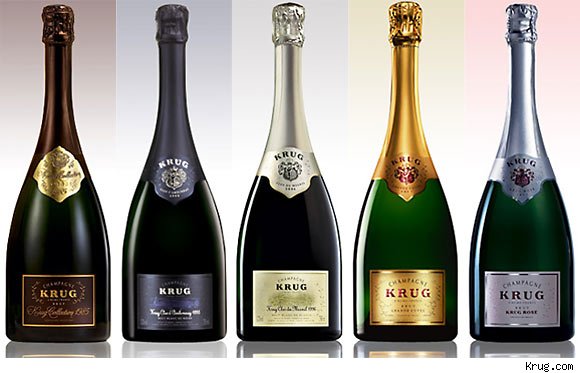 Krug
Grande Cuvée stays in the cellars for at least
seven years, Krug Rosé for at least six. A third
label, Clos
d’Ambonnay (about $2,000), is from an even
smaller, 0.68-hectare vineyard in the village of
Ambonnay. Purchased
in 1994, the vineyard produces a minuscule amount
of wine, which must wait more than ten years for
release. So
the first bottle of Clos d’Ambonnay appeared in
the market in 2007.
Krug
Grande Cuvée stays in the cellars for at least
seven years, Krug Rosé for at least six. A third
label, Clos
d’Ambonnay (about $2,000), is from an even
smaller, 0.68-hectare vineyard in the village of
Ambonnay. Purchased
in 1994, the vineyard produces a minuscule amount
of wine, which must wait more than ten years for
release. So
the first bottle of Clos d’Ambonnay appeared in
the market in 2007.
Krug intentionally diverges from standard
practices in the Champagne region by using small,
custom-made 205-liter oak casks (from 200-year-old
trees)--“to respect the individuality and
character of each single plot”-- which are cured to tamp down their
woodiness and humidified with water during the
summer to prep them to receive the autumn harvest
of grapes.
After a natural clarification, the wines
are placed in small stainless steel vats, tasted,
then, if not used for that year’s blending of
Champagne, they are stored in stainless steel for
future use. Riddling, the process of bringing
sediment in the wine to its neck to be disgorged,
takes four or five days at most Champagne houses;
at Krug it take four months.
Krug
is also unusual in that it owns a higher percentage of its
vineyards than most houses, with the rest of the
grapes coming from growers under long-term
contract.
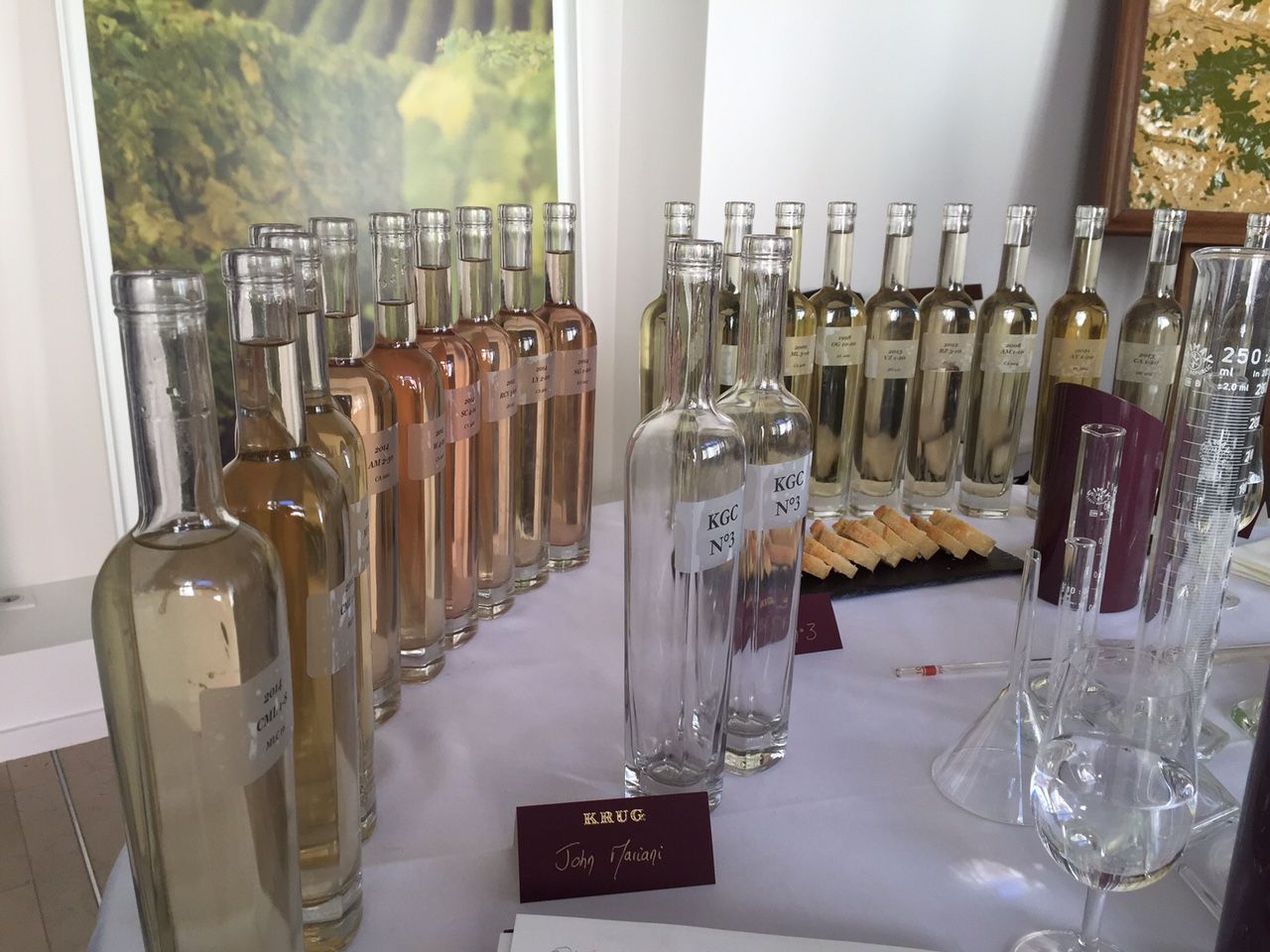 One of
Henriquez’s very modern innovations, as of 2011,
was to have all Krug bottles include an ID number
on the back label, indicating the quarter and year in
which the bottle left Krug’s cellars, so that
buyers can quite easily find out, on Krug’s
website, whatever they’d like about their specific
bottle. (It should be added that Henriquez was
brought onboard in 2008 to rescue Krug from a
rocky period a decade earlier, when there was even
thought that the house might not survive on its
own. LVMH, the French
luxury goods conglomerate, bought a
majority share of the company in 1999.)
One of
Henriquez’s very modern innovations, as of 2011,
was to have all Krug bottles include an ID number
on the back label, indicating the quarter and year in
which the bottle left Krug’s cellars, so that
buyers can quite easily find out, on Krug’s
website, whatever they’d like about their specific
bottle. (It should be added that Henriquez was
brought onboard in 2008 to rescue Krug from a
rocky period a decade earlier, when there was even
thought that the house might not survive on its
own. LVMH, the French
luxury goods conglomerate, bought a
majority share of the company in 1999.)
Perhaps the most remarkable of all the
diligence Krug expends to produce its wines is the
assemblage, or cuvée, of the wines. While
blending wines from various vats and years is
common practice in the Champagne regions of Reims
and Épernay, Krug’s tasting panel uses up to 150
different wines to make its final blend--a process
I and other wine writers partook in as a mock
exercise while we were at the house.
Over an hour of swirling, looking at bubbles,
sipping, adding milliliters of number 4 and number
15, and evaluating the various virtues and
deficiencies of a mere 18 samples of Chardonnay
and Pinot Noir (left),
our four groups of journalists from several
countries weighed the relative value of high acid
in one, sweetness in another, and, since Krug
wines are made for the long haul, a potential for
aging. We
then offered our blends and explanations for their
components to Chef de Caves Lebel. Tasting
and nodding at our efforts, he played the discreet
host by declaring all our blends interesting and
commendable,  before providing us
with the details and percentages of Krug’s final assemblage
from 150 wines.
before providing us
with the details and percentages of Krug’s final assemblage
from 150 wines.
On another night, while dining with the Krug crew
in the Clos d’Ambonnay vineyard, Maggie expounded
further on why Krug should not be considered just
a connoisseur’s wine. “Krug’s founder insisted
that people should drink Champagne purely for
pleasure, not to show off their knowledge or
affluence. It’s the reason we serve our wine in
regular white wine glasses, because they preserve
the bubbles and aromas much better than flutes or
coupes. And
we love to serve Champagne throughout the meal, as
you would a still wine. The differences between a
Chardonnay or Pinot Noir or Rosé offer enormous
latitude with both seafood and meat and certainly
with dessert.”
Dining at twilight in the little walled clos of
Ambonnay, we enjoyed a meal by the young Belgian
chef Julien Burlat of beef carpaccio (with Clos
d’Ambonnay 2000); king crab with thyme, wild
mushrooms, purslane and potato mousse (1995); the
lake fish called ombre de
chevalier with morels, sea aster and maple
butter (Krug 2000);
aged Comté cheese (1982), and
rice pudding with candied rhubarb (Grande Année).
It was easy enough to appreciate Maggie’s point
about an evening of pure pleasure while sitting
under a canopy of twinkling stars floating above
us like Champagne bubbles in the heavens.
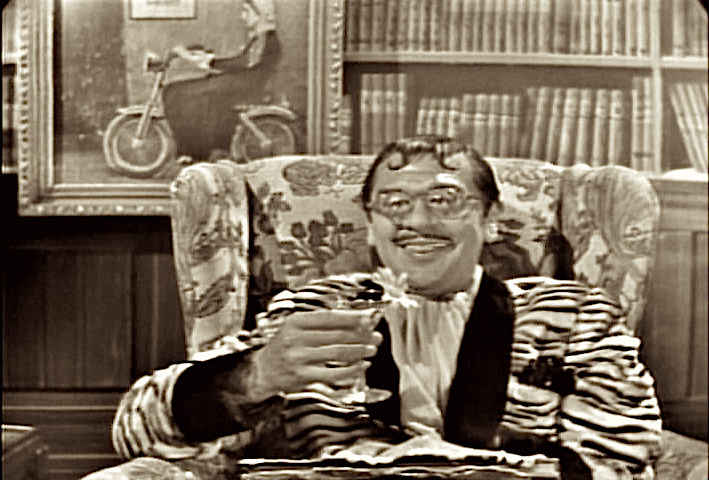 BUT THAT MAY BE BECAUSE
THEY DON'T
BUT THAT MAY BE BECAUSE
THEY DON'T SERVE KRUG IN BBQ JOINTS

A new study by the
Organization of Economic Co-operation and Development
says that people with higher levels of education
as well as socioeconomic status — mainly white men —
tend to drink the most. The research further indicates
that poor men and rich women are more likely to engage
in "risky drinking" — such as binge drinking alone —
than other subsets of the population.
 SHE ALSO SUSPECTED SOMETHING WAS WRONG
SHE ALSO SUSPECTED SOMETHING WAS WRONG WHEN HE BEGAN BITING THE MAILMAN
Any of John Mariani's books below may be ordered from amazon.com.
 I'm proud and happy to announce that my
new book, The Hound
in Heaven (21st Century Lion Books), has just
been published through Amazon and Kindle.
I'm proud and happy to announce that my
new book, The Hound
in Heaven (21st Century Lion Books), has just
been published through Amazon and Kindle. It is a novella, and for anyone who loves dogs, Christmas, romance, inspiration, even the supernatural, I hope you'll find this to be a treasured favorite. The story concerns how, after a New England teacher, his wife and their two daughters adopt a stray puppy found in their barn in northern Maine, their lives seem full of promise. But when tragedy strikes, their wonderful dog Lazarus and the spirit of Christmas are the only things that may bring back his master back from the edge of despair.
WATCH THE VIDEO!
“What a huge surprise turn this story took! I was completely stunned! I truly enjoyed this book and its message.” – Actress Ali MacGraw
“He had me at Page One. The amount of heart, human insight, soul searching, and deft literary strength that John Mariani pours into this airtight novella is vertigo-inducing. Perhaps ‘wow’ would be the best comment.” – James Dalessandro, author of Bohemian Heart and 1906.
“John Mariani’s Hound in Heaven starts with a well-painted portrayal of an American family, along with the requisite dog. A surprise event flips the action of the novel and captures us for a voyage leading to a hopeful and heart-warming message. A page turning, one sitting read, it’s the perfect antidote for the winter and promotion of holiday celebration.” – Ann Pearlman, author of The Christmas Cookie Club and A Gift for my Sister.
“John Mariani’s concise, achingly beautiful novella pulls a literary rabbit out of a hat – a mash-up of the cosmic and the intimate, the tragic and the heart-warming – a Christmas tale for all ages, and all faiths. Read it to your children, read it to yourself… but read it. Early and often. Highly recommended.” – Jay Bonansinga, New York Times bestselling author of Pinkerton’s War, The Sinking of The Eastland, and The Walking Dead: The Road To Woodbury.
“Amazing things happen when you open your heart to an animal. The Hound in Heaven delivers a powerful story of healing that is forged in the spiritual relationship between a man and his best friend. The book brings a message of hope that can enrich our images of family, love, and loss.” – Dr. Barbara Royal, author of The Royal Treatment.
 |
The Encyclopedia of American Food and Drink by John F. Mariani (Bloomsbury USA, $35) Modesty forbids me to praise my own new book, but let me proudly say that it is an extensive revision of the 4th edition that appeared more than a decade ago, before locavores, molecular cuisine, modernist cuisine, the Food Network and so much more, now included. Word origins have been completely updated, as have per capita consumption and production stats. Most important, for the first time since publication in the 1980s, the book includes more than 100 biographies of Americans who have changed the way we cook, eat and drink -- from Fannie Farmer and Julia Child to Robert Mondavi and Thomas Keller. "This book is amazing! It has entries for everything from `abalone' to `zwieback,' plus more than 500 recipes for classic American dishes and drinks."--Devra First, The Boston Globe. "Much needed in any kitchen library."--Bon Appetit. |
"Eating Italian will never be the same after reading John Mariani's entertaining and savory gastronomical history of the cuisine of Italy and how it won over appetites worldwide. . . . This book is such a tasteful narrative that it will literally make you hungry for Italian food and arouse your appetite for gastronomical history."--Don Oldenburg, USA Today. "Italian
restaurants--some good, some glitzy--far
outnumber their French rivals. Many of
these establishments are zestfully described
in How Italian Food Conquered the World, an
entertaining and fact-filled chronicle by
food-and-wine correspondent John F.
Mariani."--Aram Bakshian Jr., Wall Street
Journal.
"Equal parts
history, sociology, gastronomy, and just
plain fun, How Italian Food Conquered the
World tells the captivating and delicious
story of the (let's face it) everybody's
favorite cuisine with clarity, verve and
more than one surprise."--Colman Andrews,
editorial director of The Daily
Meal.com. "A fantastic and fascinating
read, covering everything from the influence
of Venice's spice trade to the impact of
Italian immigrants in America and the
evolution of alta cucina. This book will
serve as a terrific resource to anyone
interested in the real story of Italian
food."--Mary Ann Esposito, host of PBS-TV's
Ciao
Italia. "John Mariani has written the
definitive history of how Italians won their
way into our hearts, minds, and
stomachs. It's a story of pleasure over
pomp and taste over technique."--Danny Meyer,
owner of NYC restaurants Union Square
Cafe, The Modern, and Maialino.
|
 |
 |
 |
 |
 |
 |
 |
 |
 Everett Potter's Travel Report:
Everett Potter's Travel Report: 
 Eating Las
Vegas is the new on-line site for
Virtual Gourmet contributor John A. Curtas.,
who since 1995 has been commenting on the
Las Vegas food scene and reviewing
restaurants for Nevada Public Radio.
He is also the restaurant critic for KLAS
TV, Channel 8 in Las Vegas, and his past
reviews can be accessed at KNPR.org.
Click on the logo below to go directly to
his site.
Eating Las
Vegas is the new on-line site for
Virtual Gourmet contributor John A. Curtas.,
who since 1995 has been commenting on the
Las Vegas food scene and reviewing
restaurants for Nevada Public Radio.
He is also the restaurant critic for KLAS
TV, Channel 8 in Las Vegas, and his past
reviews can be accessed at KNPR.org.
Click on the logo below to go directly to
his site.

Tennis Resorts Online: A Critical Guide to the World's Best Tennis Resorts and Tennis Camps, published by ROGER COX, who has spent more than two decades writing about tennis travel, including a 17-year stretch for Tennis magazine. He has also written for Arthur Frommer's Budget Travel, New York Magazine, Travel & Leisure, Esquire, Money, USTA Magazine, Men's Journal, and The Robb Report. He has authored two books-The World's Best Tennis Vacations (Stephen Greene Press/Viking Penguin, 1990) and The Best Places to Stay in the Rockies (Houghton Mifflin, 1992 & 1994), and the Melbourne (Australia) chapter to the Wall Street Journal Business Guide to Cities of the Pacific Rim (Fodor's Travel Guides, 1991).


MARIANI'S VIRTUAL GOURMET
NEWSLETTER is published weekly. Editor/Publisher: John
Mariani.
Editor: Walter Bagley. Contributing Writers: Christopher Mariani,
Robert Mariani, Misha
Mariani,
John A. Curtas, Edward Brivio, Mort Hochstein,
Andrew Chalk, Dotty Griffith and Brian Freedman. Contributing
Photographers: Galina Dargery, Bobby
Pirillo. Technical Advisor: Gerry McLoughlin.
To un-subscribe from this newsletter,click here.
© copyright John Mariani 2015

